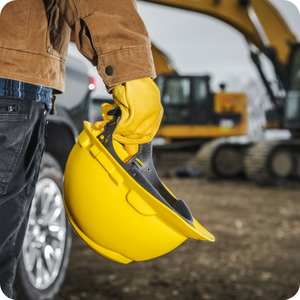As the middle of 2025 approaches, trends in the rental industry become clearer, providing a vivid picture of the factors that will shape the industry for the rest of the year. 2025 was all about businesses moving toward a rental-based model.
Rather than investing directly in heavy equipment, mid-market to enterprise construction companies preferred renting equipment, especially those pieces requiring a heavy investment. Renting equipment eliminates the need to tie up capital in expensive heavy equipment, converting fixed capital costs into operating expenditures (OPEX).
Our team at EZRentOut conducted extensive interviews to gain a deeper understanding of the perspectives of construction professionals. Ryan Flosdorf, Project Manager at Inline Commercial Construction, explained that their organization relies entirely on rented equipment: “95% of our equipment is rented,” following the OPEX strategy.
Similarly, if any equipment breaks down on site, then as part of the contract signed with their vendor—Sunbelt, in this case—the equipment is returned to the provider for maintenance. This remains a standard practice in construction, as the legal terms and conditions bind the rental equipment provider to maintain the item, while most contractors rent equipment for use.
The construction rental industry formed a closely knit community in 2025 where contractors, vendors, and construction professionals partnered with one another for sustainable growth. This level of commitment and accelerated growth has called for the use of “smart” equipment integrated with IoT sensors and AI-driven analytics, enabling real-time performance monitoring, predictive maintenance, and optimized fleet management.
The aims were to overcome the impact of global tariffs at the start of the year and break the deeply embedded data silos in construction.
This blog highlights some of the leading trends in the construction industry in 2025 so far and guides you on how to leverage those to your advantage.
Improve Your Rental Operations
Leading trends in the construction rental industry
1. A shift to digital workflows–Contractors’ ask
Construction contractors operate in highly complex and dynamic environments that require constant coordination and communication. Their true success lies in adopting solutions, such as construction equipment rental software, that can automate routine workflows and simplify their jobs.
Imagine a day in the life of a contractor without an automated rental asset management system:
They start by physically checking equipment status on site, then spend hours calling various rental companies to find available machinery, often resulting in multiple calls and wasted time. Delivery and pickup confirmations are often handled through handwritten notes and verbal agreements, which can complicate dispute resolution. Project schedules are frequently disrupted by equipment delays, as there is no real-time visibility into rental fleet availability or estimated arrival times.
Sounds frustrating, doesn’t it?
To address these challenges, contractors demanded a shift toward a digital workspace that optimizes daily operations and supports a data-driven environment. This includes automating:
- Online scheduling: This capability enables contractors to book equipment 24/7, regardless of business hours or their project manager’s availability. They can quickly assess equipment availability, reserve the needed units, and send requests via rental asset management solutions. This reduces the need for coordination through texts or calls and speeds up the booking process.
- Delivery and pickup: Using a unified system, contractors can book equipment, enter delivery or pickup details, and agree on rental terms with providers to ensure timely receipt of equipment. This helps prevent billing errors and keeps them informed about delivery status, which is critical to project success.
- Fleet tracking: One of the contractors’ main concerns is the lack of real-time updates on the condition and quantity of their fleet. With a rental management solution, they can easily check fleet status through integrated dashboards, eliminating the need for calls to site managers.
For example, United Rentals recently implemented AI-driven upgrades, such as AI-powered dashboards that optimize fleet sizes within their rental system, helping contractors spend less time searching for fleet items.

→ How can businesses naturally adapt to the digitization trend?
Mid-market rental firms risk losing customers if they do not empower their contractors with AI and automated fleet management systems. Sticking to legacy systems makes them vulnerable when increased order volumes and project deadline pressures cut into profits.
The best way to cope with this rising pressure is to take small steps toward adopting rental asset management solutions. These systems can streamline manual processes, such as automating order handling, generating receipts and invoices easily, and maintaining a comprehensive fleet catalog, providing contractors with constant visibility into their fleet.
Investing in such systems will save construction companies from the hassle of manual operations and expand their market reach.
2. Rise of micro-rental models
As construction has become increasingly specialized over time, there has been a shift in rental models. Construction companies are adopting micro-rental models, which involve hour-based, task-specific, or ultra-short-term equipment rentals, offering flexibility that traditional day or week-long rentals cannot match.
2025 marked a shift in the overall construction industry, with a focus on niche construction jobs, including solar panel installation and fiber-optic rollouts. Contractors in these niches are usually not willing to pay for equipment on a full-time basis, as it is required for only 1-2 weeks at most, which necessitates equipment availability for a few weeks.
This is where micro-rentals come in! Instead of traditional flat rates, micro-rental models offer:
- Per-hour pricing
- Usage-based billing (e.g., per engine hour or task completion)
- On-demand access via mobile apps or API integrations
You can easily provide instant rental services and ensure customer satisfaction. These types of rentals do not require contractors to pay for a piece of equipment full-time, thereby reducing operational costs.
Micro-rentals work the best for contractors who are working on short-term rentals, have multiple small-scale projects to deliver, and emergency services such as instant repairs at a job site. So, it’s not only about equipment availability, it’s also about instant access to it based on the context.
For instance, a forklift is only needed for two hours to move items around on a jobsite. The contractor does not need to hire it for the whole day and can easily reach an agreement with the vendor to rent it out for those two hours and be charged accordingly.
→ What role does technology play in enabling micro-rentals?
Technology, including rental asset management solutions, is further improving the process of micro-renting. These systems offer opportunities for per-hour and per-usage pricing, facilitated by rental meters.
Several solutions combine rental-based usage with rental asset tracking to ensure accurate rental charges are applied. Through this integration, users can also access information to optimize their rentals, eliminate “dead equity” (equipment sitting idle), and maximize asset utilization. They can also ensure “smart asset rotation” by relocating a piece of equipment for better use if a project finishes early, or a piece of equipment stays underutilized on a site.
3. Increased underutilization of fleet
As the construction industry is slowly expanding and exploring new niches, the underutilization of equipment emerges as a new challenge. This typically stems from a lack of visibility into the construction fleet, due to pre-existing and constantly reinforced data silos.
Information exists in isolation from one another and never reaches the right person on time, leading to a “dark fleet”. The dark fleet refers to equipment used across the organization that is not recorded in the systems. It usually emerges when:
- Unplanned procurement: Teams working on the site procure equipment without letting their leads know or recording the rental in the company records.
- Third-party agreements: Contractors and subcontractors often rent equipment from third parties without properly logging them.
These factors exacerbate the issues of duplicate rentals, data fragmentation, and increased operational costs.
For instance, two on-ground teams of a construction rental business ended up renting two skid-steers of the same type, leading to duplicate rentals and wasted resources. Due to the lack of a centralized platform, neither team was aware that a unit was already idle in the company’s fleet. The duplicate rental cost the company $18,000 in avoidable fees over six weeks.
→ How to avoid the risks associated with the dark fleet?
Construction companies are adopting rental platforms that offer a centralized portal to access rental information through advanced dashboards for approvals and agreements. Contractors can request equipment via a rental webstore, allowing the data to be centralized on one platform.
An approval chain can be created and automated for larger rentals to reduce the risk of unauthorized rentals or bookings.
Some advanced platforms can even trigger alerts when field activity doesn’t match system logs, helping to flag unauthorized or unlogged equipment use in real-time. All you need to do is sign up for a rental asset management system that can help automate the discovery of your rental assets while providing greater autonomy for increased asset control.

4. Cybercrimes affecting the rental industry
International Rental News reports that rental firms across North America and Europe experienced a surge in cyberattacks in early 2025, due to weak security systems. The main reasons for these attacks include:
- Unpatched legacy systems that remain unprotected and unmonitored for years.
- Customer portals and logins for the rental asset management solution that lack multi-factor authentication (MFA).
Some rental companies even reported having their profiles locked and rental records deleted, forcing them to pay ransoms to regain access.
Rental equipment providers that rely heavily on outdated systems suffer the most from cyberattacks, as these systems often lack robust security protocols, such as password policies, firewalls, and backups.
Construction rental operations usually rely on traditional frameworks that do not prioritize protecting online data, leaving them vulnerable to security breaches.
→ How to avoid security breaches?
The first step that any rental business should take is to audit its current tech stack to assess whether it is vulnerable to any attacks. This will enable them to identify gaps in their security system that can pose significant challenges to their rental operations.
But, simply assessing your current stack will not be enough. Training staff to follow best security practices is essential to ensure your system remains secure from external threats. You must only look for software providers who follow the industrial protocols for handling data. Look for systems that have encryption capabilities and follow GDPR policies for protecting your data online.
5. Increased demand for local rental equipment
In 2025, the construction rental industry is seeing a surge in localized equipment demand driven by large-scale infrastructure and industrial development projects across North America. The United States government allocated a massive amount of $12+ billion in civil projects to improve the infrastructure. At the same time, the private sector experienced a surge in investments, particularly in data centers and EV battery plants.
These investments translate into increased demand for rental construction equipment, particularly high-value items such as earthmoving equipment, aerial lifts, light towers, cranes, and backup power systems. This has increased pressure on rental companies to supply high-value equipment within a specified timeframe. Similarly, opportunities for subcontractors also increased, as general contractors needed the timely delivery of short-term rental equipment.
For instance, in June 2025, British rental firm Ashtead—which operates Sunbelt Rentals in the U.S.—reported that while construction growth in traditional non-residential segments had softened, “mega project” activity remained robust, particularly in data centers, semiconductors, and LNG infrastructure. These large-scale developments are sustaining strong rental revenue, compensating for weaker demand elsewhere in the sector.
→ How can contractors adjust to the surge in construction projects?
An increase in government-backed initiatives means an increase in job opportunities in construction, requiring contractors and subcontractors to be aligned. Sub-contractors need to be well-equipped with the latest equipment in line with the trending asset mixes to fulfill a variety of projects.
Similarly, contractors must be able to track both rented and owned equipment to better assess their performance and usage, enabling timely maintenance and efficient project delivery. For instance, if a contractor has to provide a forklift to another construction site immediately, they should be able to track, in their records, their latest location and custodian.

The future of rental asset management
Rental asset management is evolving at a faster pace than ever. Digital workflows, including widespread use of SaaS-based rental solutions, are transforming how we manage rental operations. The integration of AI into daily workflows is becoming standard! For intelligent fleet management and overseeing contractors, smart asset management is the way forward.
In 2025, scalability, flexibility, and easy adaptability remained the core areas construction companies looked to adopt throughout the year. Economic conditions, technological advancements, and industrial growth continued to be the key drivers of these core values that construction companies sought to achieve.
SaaS adoption remains uneven, with only about 45% of rental providers utilizing effective fleet management strategies. Software needs also vary, as most construction companies require more than just a reservation system. They require a combination of capabilities that offer extensive customization and enable higher asset utilization.
Frequently Asked Questions
What equipment types are seeing the highest rental demand now?
Scissor lifts, boom lifts, telehandlers, skid steers are popular. These offer high ROI and are frequently rented due to their utility and lower maintenance compared to heavy machines.
Is it profitable to buy heavy construction machines to rent out?
Only if utilization is very high, maintenance costs are controlled, and downtime minimal. Profit margins often take years because upfront and upkeep costs are steep.
What pricing strategies work best in construction equipment rentals?
Use flexible rates (daily, weekly, monthly), include fees for delivery/pickup, factor in downtime, and keep margins that account for maintenance & depreciation.
How much do repair & maintenance costs eat into profits?
Quite a bit. Rentals are abused, costs add up quickly. Good maintenance regimes and condition checks are essential to protect margins.
What trends are pushing customers toward renting instead of buying?
Availability (wanting equipment ASAP), avoiding ownership/repair burden, flexibility, and matching demand peaks without owning idle assets.
How important is having good maintenance to avoid losses?
Extremely important: bad maintenance leads to more downtime, repairs, lower resale, reduced customer trust—costs spiral faster than often expected.
What risks should new rental business owners prepare for?
Equipment damage/abuse, delayed returns, high repair costs, insurance liability, competition from large providers, and hidden costs (transport, storage).
Is demand shifting toward smaller or specialty tools?
Yes—smaller, lighter, higher-volume tools (power washers, compressors, generators) are attractive due to lower risk and faster returns.
How do online platforms & digital tools impact equipment rental trends?
They make booking easier, increase transparency, improve utilization via tracking, help manage maintenance & inventory. Digitization is a growing advantage.
What are the biggest logistical costs in construction equipment rentals today?
Delivery/pick-up, fuel, insurance, storage, repair parts, and transport between sites. These often eat into margins if not budgeted well.
How do equipment rentals deal with regulatory / safety inspection requirements?
By scheduling regular inspections, using certified mechanics, keeping detailed records, ensuring compliance with safety regulations—non-compliance causes legal & financial risks.
How much does market saturation matter in a rental business?
A lot. If many rental services exist locally, competition on price and condition is stiff. Differentiation via service, condition, pricing, availability become key.
What growth trends are emerging in construction equipment rentals?
Increased tech usage (telemetry, IoT), more demand for flexible renting, higher demand in urban projects with space constraints, and specialty equipment for niche jobs.
How do asset tracking & utilization data help rental businesses?
They reveal idle machines, optimize fleet size, flag under-used gear, and improve decision-making for purchases & maintenance schedules.
What role does insurance & liability play for rental companies?
Huge role. Costs for damage can be substantial. Rental contracts need damage waiver clauses; insurance needs to cover usage, accidents, transit.
How long does it take for a rental piece of equipment to become profitable?
Often several months to a few years, depending on cost, maintenance, usage frequency, depreciation, and resale value.
What features do customers increasingly expect in rental companies?
Transparent pricing, online booking, condition photos, fast delivery/pick-up, digital contracts/signatures, flexible rental durations.
How can EZO tools help equipment rental businesses stay ahead of these trends?
EZO’s tools help track utilization, automate maintenance, monitor equipment condition, digitize booking/inventory, and generate real-time usage & cost reports—supporting smarter decisions in changing markets.
Was this helpful?
- Leading trends in the construction rental industry
- 1. A shift to digital workflows–Contractors’ ask
- → How can businesses naturally adapt to the digitization trend?
- 2. Rise of micro-rental models
- → What role does technology play in enabling micro-rentals?
- 3. Increased underutilization of fleet
- → How to avoid the risks associated with the dark fleet?
- 4. Cybercrimes affecting the rental industry
- → How to avoid security breaches?
- 5. Increased demand for local rental equipment
- → How can contractors adjust to the surge in construction projects?
- The future of rental asset management
- Frequently Asked Questions
- What equipment types are seeing the highest rental demand now?
- Is it profitable to buy heavy construction machines to rent out?
- What pricing strategies work best in construction equipment rentals?
- How much do repair & maintenance costs eat into profits?
- What trends are pushing customers toward renting instead of buying?
- How important is having good maintenance to avoid losses?
- What risks should new rental business owners prepare for?
- Is demand shifting toward smaller or specialty tools?
- How do online platforms & digital tools impact equipment rental trends?
- What are the biggest logistical costs in construction equipment rentals today?
- How do equipment rentals deal with regulatory / safety inspection requirements?
- How much does market saturation matter in a rental business?
- What growth trends are emerging in construction equipment rentals?
- How do asset tracking & utilization data help rental businesses?
- What role does insurance & liability play for rental companies?
- How long does it take for a rental piece of equipment to become profitable?
- What features do customers increasingly expect in rental companies?
- How can EZO tools help equipment rental businesses stay ahead of these trends?









